 Shingles: Symptoms, Risk Factors, and Natural Support Strategies
Shingles: Symptoms, Risk Factors, and Natural Support Strategies
Shingles is an infection caused by the same virus that causes chickenpox. The virus can remain dormant in your body and reactivate itself causing shingles, an illness characterized by red skin rashes, blisters, fever, fatigue, muscle aches, and headaches. If you get shingles, the good news is that you can support your health and ease your symptoms with a variety of natural support strategies.
In this article, you will learn what shingles is. You will understand the symptoms and risk factors of shingles. You will understand the relationship between shingles and chickenpox vaccination. I will discuss the connection between vitamin D deficiency and shingles. You will learn about conventional treatment methods for shingles. I will also share my top natural support strategies for shingles.

What Is Shingles
Shingles is an infection caused by the varicella-zoster virus. This is the same virus that is responsible for chickenpox, a common infection in childhood (1). According to the Centers for Disease Controls and Prevention (CDC), about 1 in 3 people will experience shingles at one point in their lives. It rarely happens more than one time in the same person.
If you’ve had chickenpox, the virus may remain in your body for years and reactivate as shingles at one point. Like chickenpox, shingles is characterized by a red skin rash that causes burning and pain. It usually looks like a stripe of blisters on one side of your body, typically on your neck, torso, or face.
Shingles usually clear up within 2 to 5 weeks depending on the person. Your symptoms of burning and pain will be the most intense for the first 5 days. Within a few days, your rashes will turn into fluid-filled blisters that will dry up and crust over within 7 to 10 days. It will take another couple of weeks for the scabs to completely clear up (1, 2).

Major Symptoms of Shingles
The visible symptom of shingles is a rash that is characterized by (1, 2):
- Red patches
- Fluid-filled blisters that break easily
- Itching
- Pain
- Rashes and blisters around the spine and torso
- Rashes on the face, neck, and ears
Other symptoms of shingles beyond the painful and itchy rashes may include (1, 2):
- Fever
- Chills
- Fatigue
- Headache
- Muscle weakness
In rare cases, shingles can lead to the following symptoms and complications:
- Rash or pain around the eye, which needs immediate treatment to avoid permanent eye damage
- Loss of hearing, earache, dizziness, or loss of taste, which may be the symptom of Ramsay Hunt syndrome that need immediate medical attention
- Bacterial infections causing redness, warmth, and swelling of the skin
Risk Factors for Shingles
Shingles can develop in anyone who had chickenpox, but there are certain risk factors that may increase your chances.
Risk factors of shingles include (2):
- Being age 60 or older
- Having had chemotherapy or radiation treatment
- Taking medications that weaken your immune system, including steroids, immunosuppressants, and medications given after an organ transplant
- Having any health conditions that weaken your immune system, including HIV/AIDS and cancer
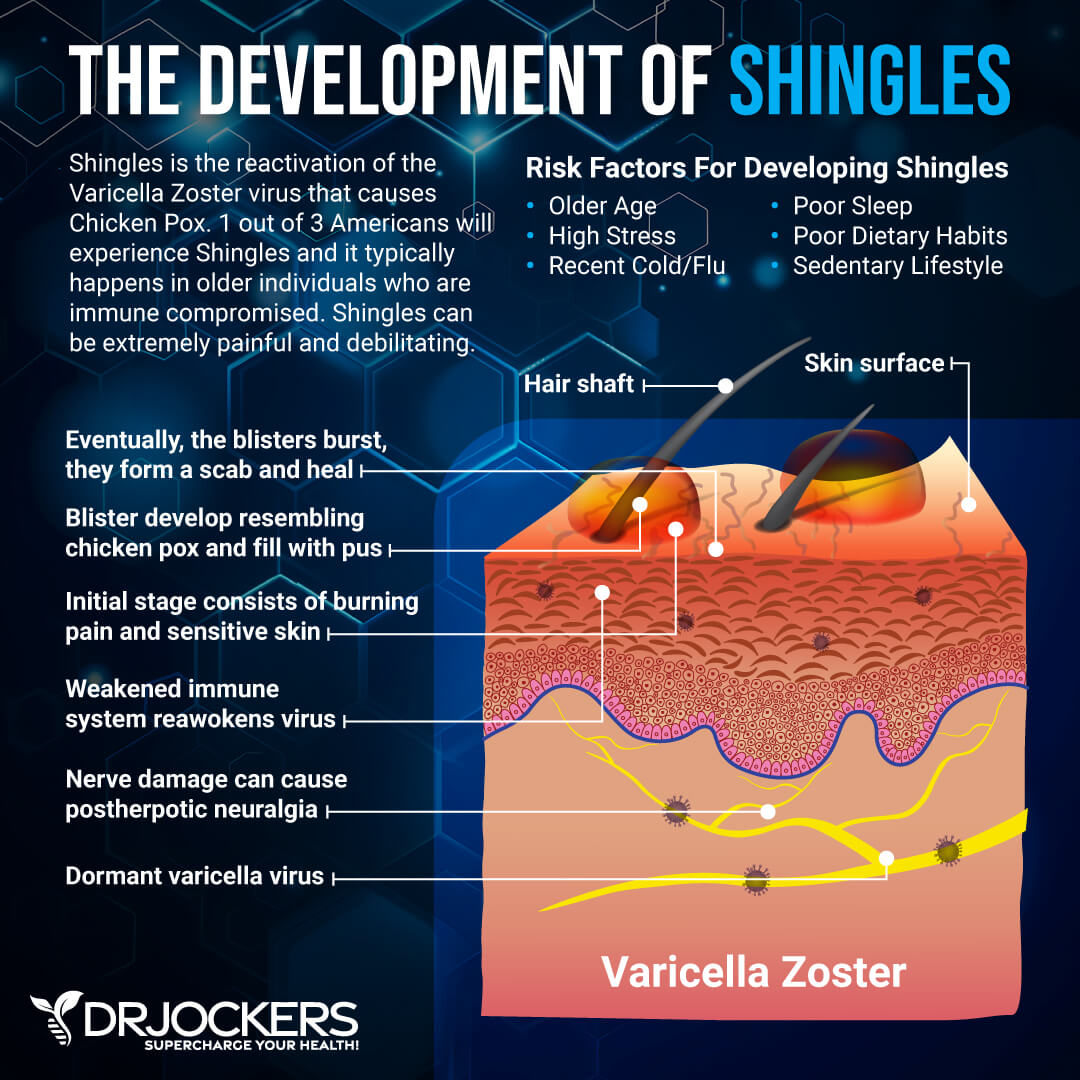
Chicken Pox Vaccine and Shingles
Back in the day, chicken pox parties were the norm. Today, vaccinating our children against chicken pox is part of the commonly advised vaccination protocol. But will the chicken pox vaccine protect our children from shingles as well? It turns out that the reality is actually the opposite.
According to a 2015 study published by eLife, vaccinating one-year-olds against chicken pox may temporarily double their risk of getting shingles (3). It was thought that the chicken pox vaccine reduces the risk of shingles for up to 20 years. As it turns out, this only lasts for two years increasing the risk of shingles in young adults from re-exposure.
The symptoms of chicken pox are mild, and children tend to get through it easily when they get it. Shingles tends to be a much more difficult illness with prolonged pain that is hard on adults.
It makes you question if vaccinating against a common and less serious childhood illness while increasing the risk of a more painful illness in adulthood is worth the risk. If you consider the other risk related to vaccinations, I’ve written about here before, you may reconsider getting your child vaccinated against chicken pox. The decision should be yours.

Vitamin D Deficiency and Shingles
Vitamin D is a very important nutrient for your immune system, muscle, bones, dental, brain, hormonal, and heart health, and other areas of your health. Vitamin D deficiency can cause or contribute to a list of symptoms and health issues. It has also been linked to shingles.
According to a 2015 study published in Medical Hypotheses, because of its role in the immune system, vitamin D deficiency is closely linked to pathogenesis and complications of shingles (4). A 2019 retrospective study published in Nutrients have found that vitamin D deficiencies have been associated with shingles and neuropathic pain (5).
A 2016 study published in the Korean Journal of Family Practice has found that subjects who got shingles during the period of the study had statistically lower levels of vitamin D than subjects who didn’t get shingles. Researchers stated that other factors, including sex, age, smoking, drinking, and the season, could also influence the incidence of shingles (6).

Conventional Treatments
To avoid complications and speed recovery, it is generally recommended to start treatment within 72 hours of the occurrence of symptoms. Conventional treatment strategies for shingles include a variety of medications along with a few simple natural methods for symptom relief (1, 2).
Oral anti-inflammatories, including ibuprofen are used for pain and swelling. Oral antiviral medications, including acyclovir, valacyclovir, and famciclovir may be prescribed to reduce pain and speed recovery. Oral narcotic medications or analgesics may be used for pain relief.
Oral anticonvulsant or tricyclic antidepressants may be prescribed for prolonged pain. Oral antihistamines, such as diphenhydramine (Benadryl) may be used for itching. Topical numbing gels, creams, and patches, such as lidocaine may be used for pain. Topical capsaicin (Zostrix) may be prescribed to reduce the risk of postherpetic neuralgia, a nerve pain that may occur after the recovery from shingles.
In addition to medications, conventional doctors may also recommend wet compresses, calamine lotion, and colloidal oatmeal baths to further reduce itching. They may also recommend loose fitting, natural fiber-clothing, balanced meals, reducing stress, and rest.
While I love that some conventional doctors may also recommend some natural and lifestyle strategies, you may not be surprised that I recommend a medication-free approach with the help of a comprehensive list of natural support strategies.

Natural Support Strategies
About one third of adults will experience shingles during their adult lives (1). The good news is that if you get shingles, you can use a number of natural support strategies to feel better and regain your health. Here is what I recommend:
Antiviral Nutrition Plan
A weakened immune system can increase the symptoms and risk of complications of shingles. Following an antiviral nutrition plan rich in anti-inflammatory and antiviral whole foods can improve your symptoms and support your recovery. The foods that you are eating can either help or suppress viral growth in your body.
Lysine is an essential amino acid that plays an important role in collagen formation, calcium absorption, cholesterol regulation, and growth and development. It also helps to support the immune system and suppress viral growth. A 2017 review published in Integrative Medicine (Encinitas) has discussed the antiviral benefits of lysine when it comes to the herpes simplex virus (7). Arginine is an amino acid that stimulates viral growth. Clearly, eating a diet high in lysine and low in arginine is important when you are dealing with viral infections.
Foods high in lysine and low in arginine include wild-caught salmon, grass-fed dairy (cheeses and yogurts), pastured and organic poultry, and grass-fed beef. Additionally, eat plenty of lemons, limes, cranberries, and avocados, lots of organic vegetables, herbs, and spices, healthy fats, like avocados, olives, coconuts, grass-fed butter or ghee, and coconut oil, and clean protein, including grass-fed meat, pasture-raised poultry and eggs, and wild-caught fish.
Avoid refined sugar, refined oils, processed foods, junk food, artificial ingredients, conventionally raised and processed meat and dairy, gluten, and food additives.

Intermittent and Extended Fasting
Fasting is a great way to support your recovery from viral infections, like shingles. Intermittent fasting is a way of eating that cycles between periods of eating and not eating within a day. Extended fasting means that you are not consuming any food, only water and non-caloric liquids for a day, several days, or even weeks.
According to a 2016 review published in Ageing Research and Review, intermittent fasting can improve your health and reduce the risk of disease (8). Intermittent fasting stimulates cellular autophagy and reduces inflammation. If you are new to fasting, I recommend that you start with the simple fast, which involves 12 hours of fasting (including your overnight sleep) and 12 hours reserved for meals within a day.
After 1 or 2 weeks, you can start increasing your eating window. Once you are experienced with intermittent fasting, you may try extended fasting for up to 5 days. Intermittent fasting and extended fasting are good strategies you can do even if you don’t have shingles to support your health and reduce your risk of health issues.

Reduce Stress & Improve Sleep
Whether you are dealing with shingles or any other health issue, reducing stress and improving your sleep are key. To reduce your stress levels, I recommend that you try meditation, progressive muscle relaxation, guided visualizations, and breathwork.
Practice gratitude and engage in prayer. Practice a positive mindset. Move your body. Even if you are sick, it’s important that you stretch or try some short yoga or light walk if you are up for it.
Make sure to sleep 7 to 9 hours a night. If you are sick, honor your body by resting, sleeping more, or taking naps as needed. Develop a relaxing nighttime routine. Support your circadian rhythm by going to bed at the same time and waking up at the same time each day. Make sure that you have a comfortable and supportive bed, mattress, bedding, and pillows, and your bedroom is a calming, safe sanctuary.

Use a Cold Compress
The symptoms of shingles can be painful and uncomfortable. To reduce pain, I recommend that you use a cold, wet compress on shingles blisters. The cooling feeling can reduce pain, sensitivity, and itching.
Just wet a washcloth under cool water and use it as a compress over your blisters. Make sure to use a new washcloth for each session to avoid spreading the virus. Use it as needed throughout the day.

Take a Healing Bath
It is important that you cleanse your blisters daily to lower the risk of spreading the shingles infection. I recommend taking a cool bath or shower. Cool water can reduce pain and calm itchiness. I also recommend taking healing baths. Taking daily healing baths can reduce your symptoms of itching, burning, and pain.
Add 1 to 2 cups of colloidal oatmeal or cornstarch to a bathtub full of lukewarm bathwater. Avoid hot water as it can increase blood flow and worsen your shingles. But make sure that your water is not too cool to sit in it for a while, so I recommend lukewarm water.
Soak for 15 to 20 minutes then dry yourself completely. Make sure to wash your towel and use a new towel for your next bath to avoid spreading the virus to others or across your own body.
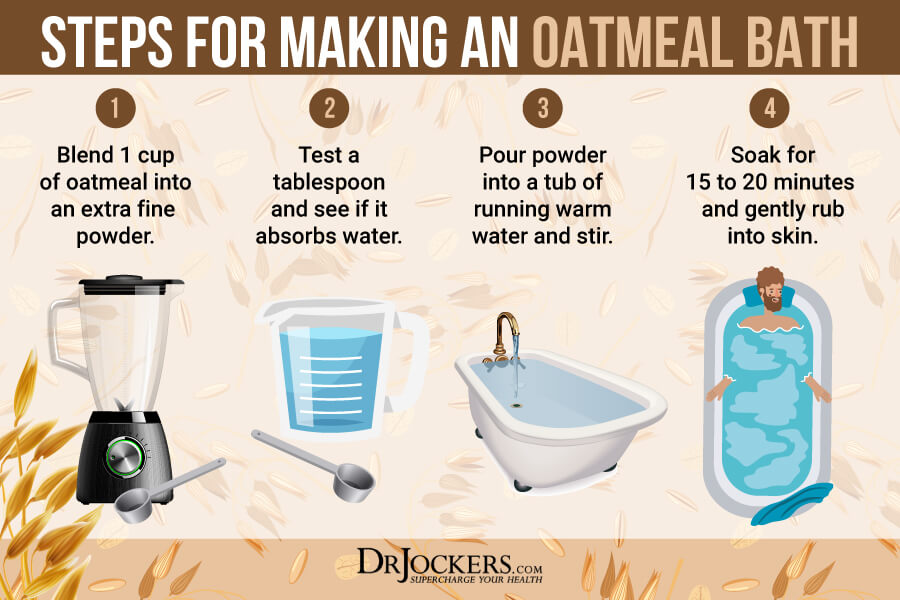
Apply Honey to Affected Region
Honey is a wonderful antiviral, antimicrobial, and anti-inflammatory remedy. A 2012 in vitro study published in the Translational Biomedicine Journal has found that manuka honey and clover honey both has antiviral benefits against shingles and have shown potential as a natural remedy (9).
I recommend that you apply honey directly on your blisters a few times a day. Look for a raw, local honey source for the best benefits.
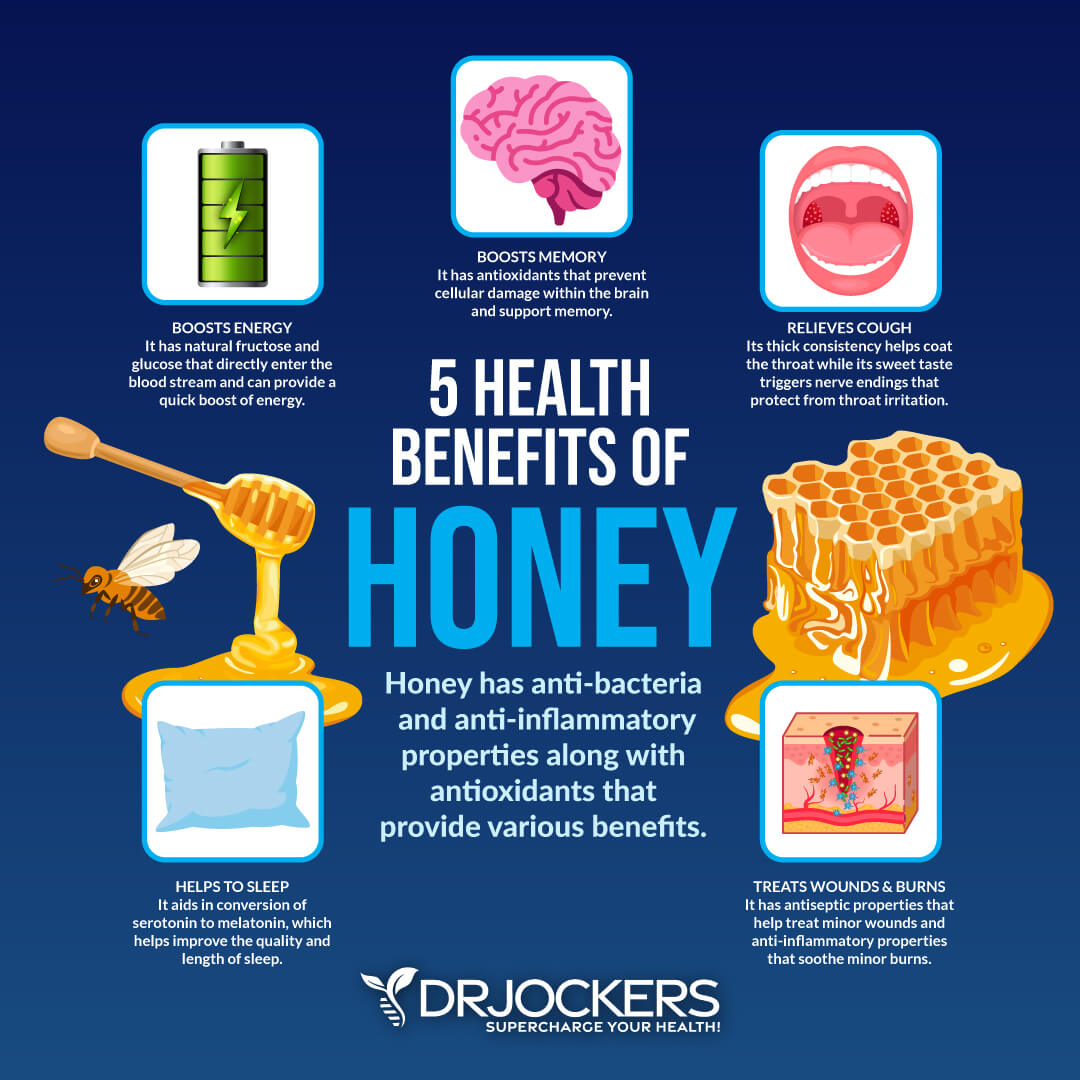
Baking Soda and Cornstarch Paste
To relieve the symptoms of a shingles rash or blisters naturally, I also recommend trying a baking soda or cornstarch paste. Add two parts baking soda or cornstarch and one part water into a cup. Mix it well until you achieve the desired consistency.
Apply the paste on your rash and leave it on for 10 to 15 minutes. Rinse it off and dry it well. Repeat it several times a day as you feel it’s needed. Make sure to use a new towel each time.
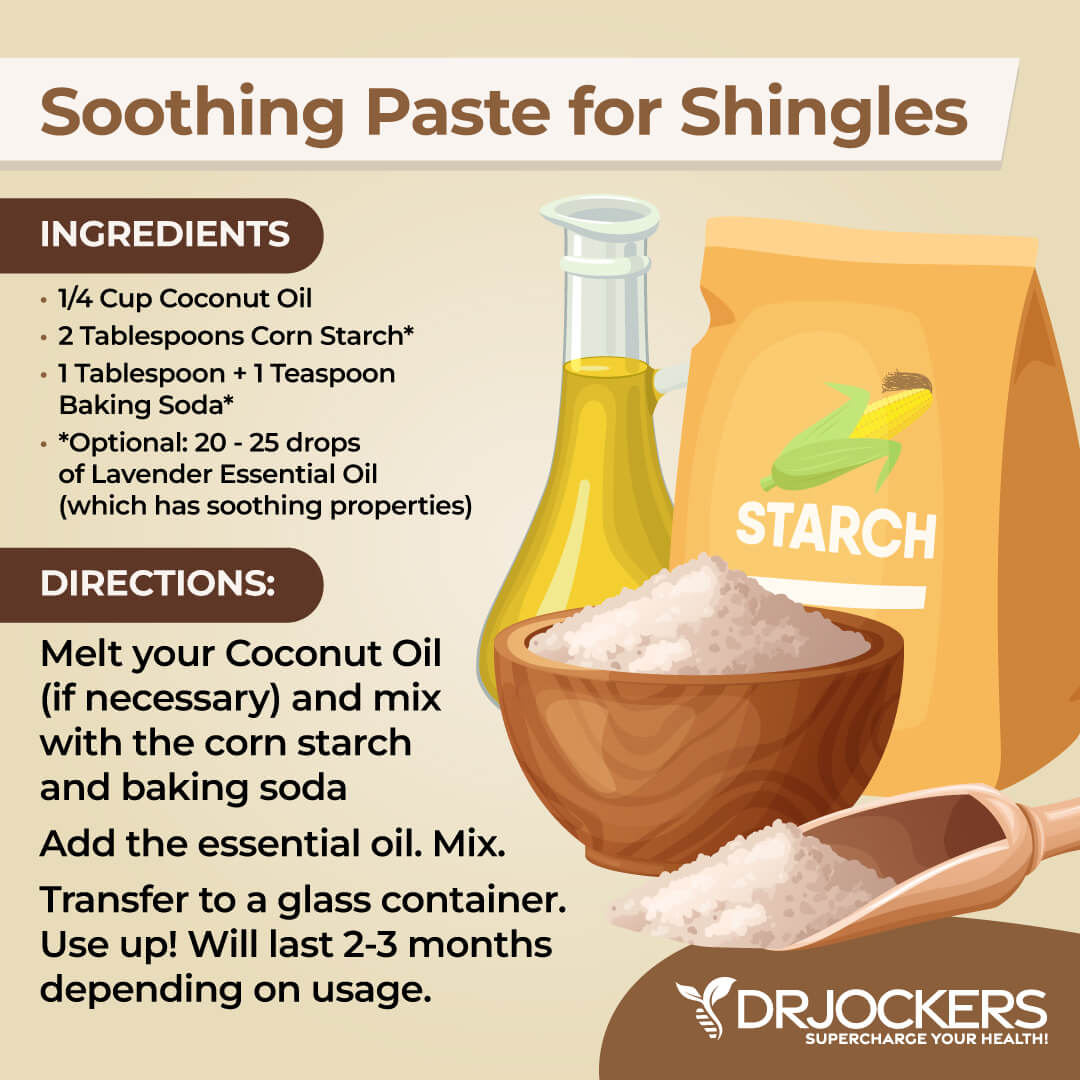
Support Lymphatic Health
Shingles can affect your internal organs and systems by turning into internal shingles. Your lymphatic system helps to get rid of toxins, waste, and other unwanted materials. It also supports your immune system.
I recommend that your support your lymphatic system by regular rebounding and daily dry brushing. Use a soft natural brush to dry brush your body daily before your daily shower. Use circular motions towards your heart.

Immune Support Nutrients
In addition to these strategies, I also recommend some immune support nutrients for shingles. Here is what I recommend:
Vitamin D
Studies have shown that vitamin D deficiencies can worsen your symptoms of shingles (4, 5, 6). You should look to get your vitamin D levels up to the 50-100 ng/ml level and test your levels at least twice a year to ensure they stay in this range.
To optimize your vitamin D levels, I recommend that you get some sunshine daily, eat foods rich in vitamin D, such as oily fish, liver, and egg yolk, and take a high-quality vitamin D supplement daily.

Zinc
Zinc deficiency may also make your experience with shingles worse. According to a 2019 study published in Advances in Nutrition, zinc plays a role in antiviral immunity in a variety of viral infections, including HIV and hepatitis C. (10).
I recommend eating a variety of foods that are rich in zinc, including oysters, red meat, and seafood. I also recommend that you take a daily zinc supplement.

Vitamin C
Vitamin C may also be helpful for shingles. According to a 2020 review published in Expert Review of Anti-infective Therapy, vitamin C has antiviral properties (11). According to a 2012 multicenter prospective cohort study published in Medical Science Monitor, using vitamin C intravenously may benefit the treatment of shingles (12).
I recommend that you load up on vitamin C-rich foods, such as lemon, limes, other citrus, strawberries, and kiwi. Additionally, I recommend that you take a high-quality vitamin C supplement daily.

L-Lysine
A 2017 review published in Integrative Medicine (Encinitas) has found that lysine has antiviral benefits (7). Lysine helps to balance the amount of arginine in our system and arginine promotes viral growth.
I recommend eating foods high in lysine and low in arginine including wild-caught salmon, grass-fed dairy (cheeses and yogurts), pastured and organic poultry, and grass-fed beef. Additionally, I recommend that you take an L-Lysine supplement.
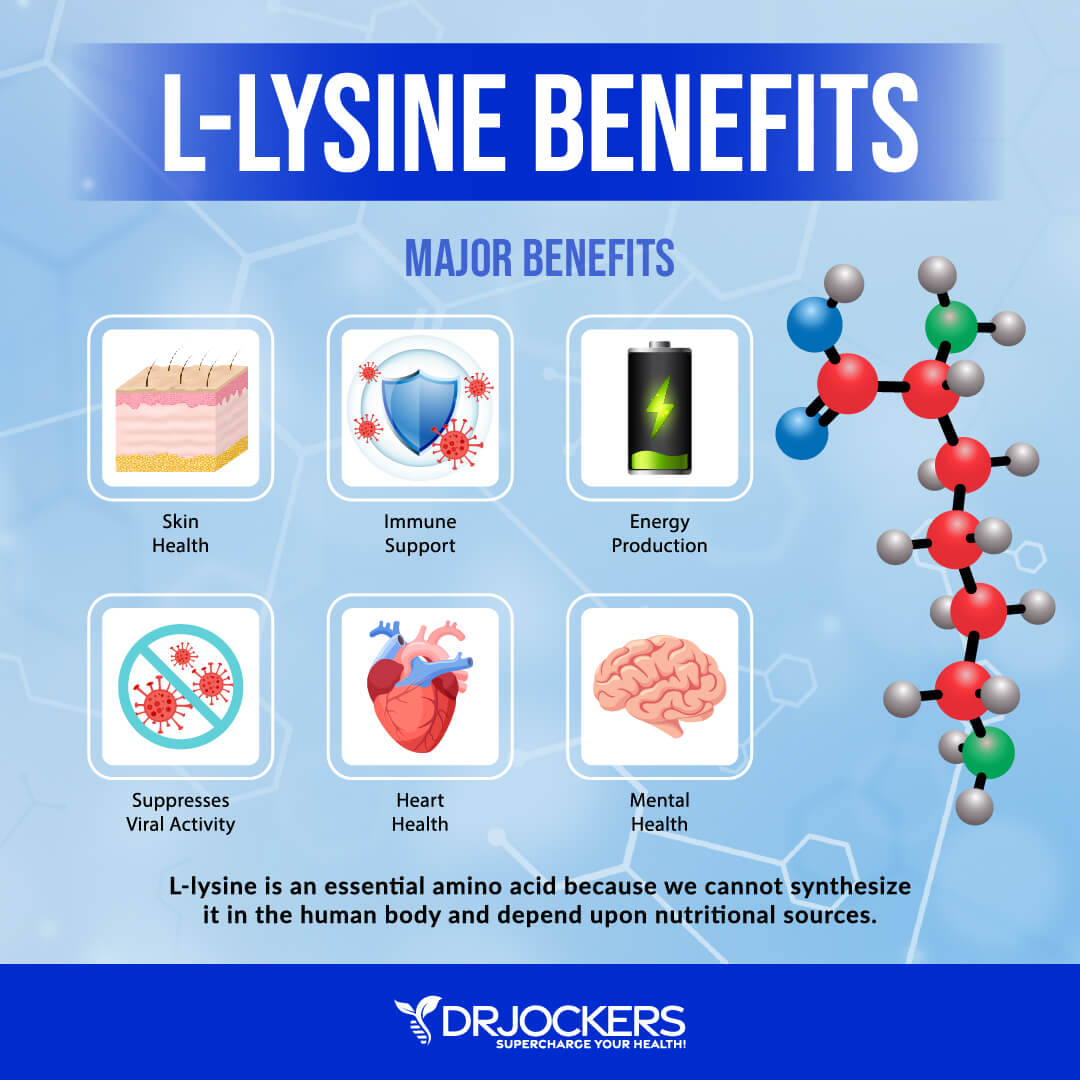
Anti-Viral Herbs
Taking antiviral herbs can help to fight the shingles virus internally while supporting your immunity. According to a 2014 study published in the International Journal of Molecular Sciences, the active ingredient of olive leaf extract, oleuropein has anti-inflammatory and antioxidant benefits (13).
A 2016 randomized, double-blind study published in PLoS One has found that broccoli sprouts have antiviral benefits (14). 2018 research published in Evidence-Based, Complementary and Alternative Medicine has shown that mulberry juice and seeds also have antiviral benefits (15). I highly recommend that you take olive leaf extract, broccoli sprouts extract, and mulberry extract supplements for their antiviral benefits.

Bioactive Carbons
Bioactive carbons help to create and sustain life in a cell. According to 2019 study published in the Journal of Inorganic Biochemistry, they are essential metals for humans (16).
There are two different plant-based acids that are bioactive carbons: fulvic and humic acid. They can help to support your immune system in fighting viruses and other pathogens. I recommend taking bioactive carbons daily during your shingles infection.
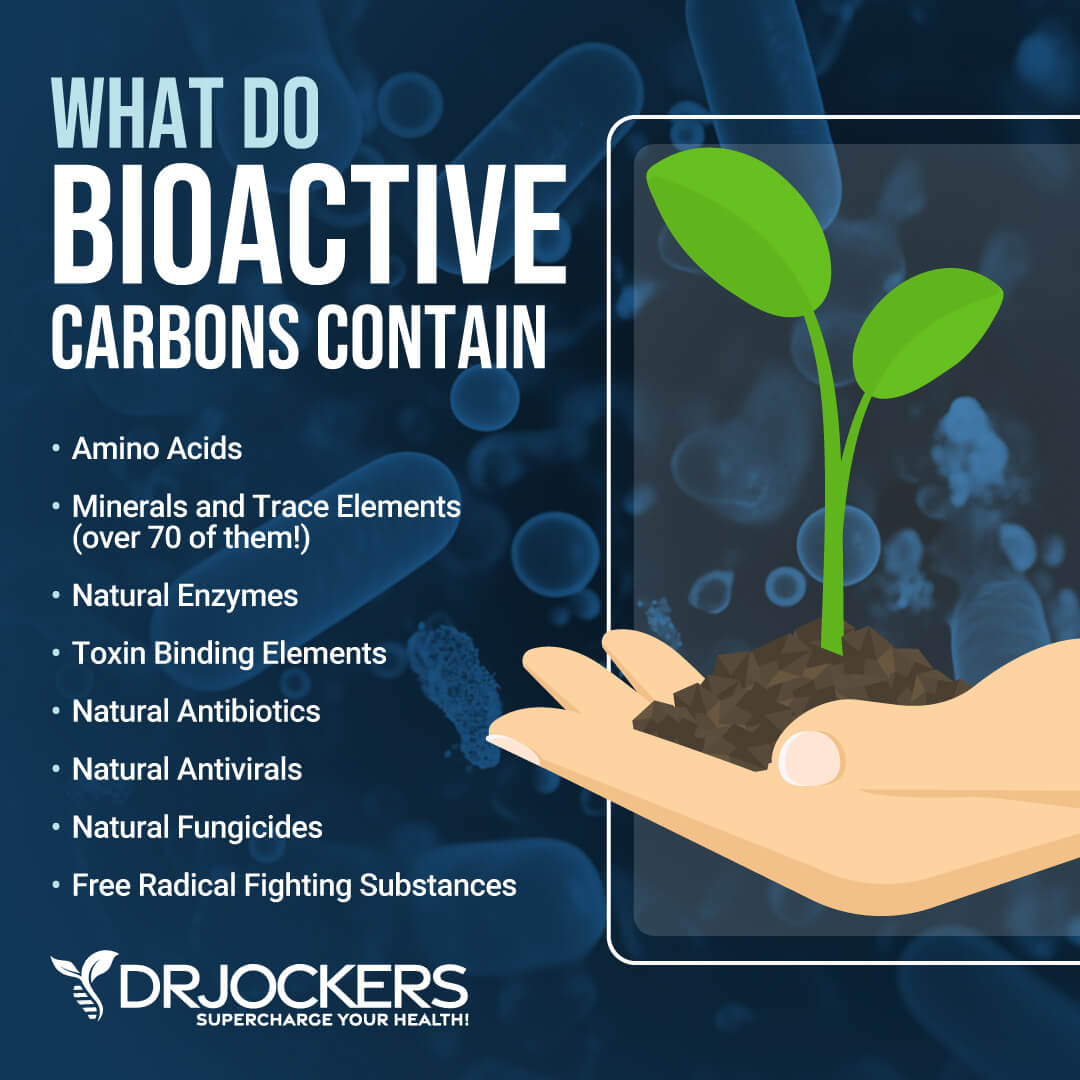
Inflammation Crushing Ebundle
The Inflammation Crushing Ebundle is designed to help you improve your brain, liver, immune system and discover the healing strategies, foods and recipes to burn fat, reduce inflammation and Thrive in Life!
As a doctor of natural medicine, I have spent the past 20 years studying the best healing strategies and worked with hundreds of coaching clients, helping them overcome chronic health conditions and optimize their overall health.
In our Inflammation Crushing Ebundle, I have put together my very best strategies to reduce inflammation and optimize your healing potential. Take a look at what you will get inside these valuable guides below!
Final Thoughts
Shingles is an infection caused by the same virus that causes chickenpox. If you get shingles, you can support your health and ease your symptoms naturally. Try my top natural support strategies for shingles.
If you want to work with a functional health coach, I recommend this article with tips on how to find a great coach. Our website offers long-distance functional health coaching programs with our world-class team of health coaches. For further support with your health and other goals, just reach out—our fantastic coaches are here to support your journey.




It was good to see that you mentioned the amino acid lysine and the need to balance with arginine.It is true to include food high in lysine, but you need to consider the OTC product Super Lysine + topical and oral tablets. I have both used and prescribed these products many times with great success.The burning itching and pain is usually relieved in hours of applying,and along with the tablets can stop the blisters from erupting. I have been in health care since 1954, and have progressed from conventional to alternative practices.
George M hospital corpsman 1954-1957, NY LPN, 1958-1963, multi states pharmacist (both conventional and alternative1963-to present(retired at age 80) certified nutritional consultant, certified wellness couch,holistic health practitioner 2000-present.
Yes supplemental lysine is very helpful. Unfortunately, the FDA/FTC does not allow us to promote a specific product in any of our “disease specific” articles.
Dr. Jockers,
I am a female age 78. Do you recommend the Shingles vaccine?
I may have had a very mild case of Shingles when i was in my 30’s. On my face. It didn’t hurt (strange?)
Also, I had the usual Chicken Pox as a child.
My husband had shingles last year
Annie
Hello Annie, no we do not recommend the Shingles vaccine as it contains dangerous ingredients and is not highly effective or safe.
Thank you for your reply here from three years ago. This page is packed so full of great information. I just had shingles in my eye! I’ve been using integrative medicine since I was a teenager, since 1975.
My mistake, though! I let my D3 level fall to 37. I was surprised that it dropped so low, but Dr. Carolyn Dean had warned about taking more that 1000-2000 IU D3, so I reduced the dose for a time – instead of taking my usual 5000 D3/K2, I starting using up some 1000 D3 that we had in the house. This probably made me more susceptible to shingles, in addition to the high stress of working very extended hours on very tedious work since January. (My other half and I had D3 levels of 59 & 60 which helped get us both through Delta C19 pneumonia in September 2021, in spite if my autoimmunity & pernicious anemia.)
I was also taking my usual free amino compound rx (based on Doctors’ Data results), olive leaf, zinc, and vitamin C, including intravenous C during my acute eye shingles, which I always take, along with ginger and MSM, etc. Eye doc says I’ve avoided scarring of my cornea; the shingles dendrites are gone.
I will be more vigilant about my D3 levels, and will buy some lysine to take in addition to the lysine that’s in my free amino compound rx, when an antiviral is needed. Your tips on foods high in arginine is also so helpful. (I would have stopped eating nuts during acute shingles if I had seen this earlier.)
Thanks so much for such helpful informative, detailed information. And for confirming in another reply to skip the shingles vaccine. I’m pretty sure the local docs would like to push that on me once a period of time has elapsed since my shingles recovery. (I really don’t trust ANY shots anymore – not even a basic tetanus shot, since Pharma is completely untrustworthy. If I ever agree to any kind of more harmless shot (if there is such a thing), I would want a trusted integrative pharmacist to compound it – which they probably don’t do.
So glad to hear you got a lot of value out of this!
Thank you so much for this information. I have had shingles multiple times, unfortunately, and my doctor keeps pushing me to get the shingrix vaccine. I have read about it and not convinced it will do anything, other than make a drug company money. You have given me some new things to do in this article that I have not done before.
Glad this could be so helpful for you Lars! Blessings!
Half of my face and head still have a shingles for 3 years. Will it have cure or non. I’m 60 and Diabetic
Sorry to hear this! I would apply the strategies in this article and be sure to heal the insulin resistance and diabetes. Here is a helpful article on that topic: https://drjockers.com/insulin-resistance/
In your article about zinc, it was stated that zinc supports the P53 gene. So, my question is, if someone with AML P53 gene mutation, takes zinc, is it supporting the gene or the mutation?
Yes it supports optimal function of the enzyme so you have the cellular DNA protection.
Dear Dr. Jockers,
Thank you for this informative article.
1. What LYSINE dose would you advise for cases of CHRONIC ACTIVE SHINGLES and how long can one take the dose?
2. What LYSINE dose would you advise as a maintenance or preventative dose once the chronic active shingles seems to be under control?
Thank you! You would be a great person to host a Virus Summit!
Hello Beth,
Usually 1.5-2 grams, 3 times daily is good for reducing active shingles while around 0.5-1 gram – 2x daily is a great dosage for maintenance.
Got rid of Hsv,,Worked for me,,,,,,,,,,,,,